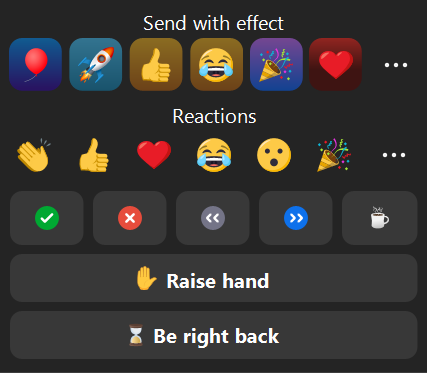Everything You Need to Know About Zoom Reactions
August 14, 2024
August 14, 2024
December 9, 2025
December 9, 2025
Zoom reactions help you express yourself in a Zoom meeting without needing to speak. They give you quick visual cues that keep conversations clear. You can show support, slow the presenter, or ask to talk with one simple emoji reaction.
Here is what you will learn in this article:
- What Zoom reactions are
- How meeting reactions work
- When to use emoji reactions
- How to manage and enable reactions
- How Tactiq complements Zoom reactions and boosts meeting productivity
As you explore these reactions, you may still want a clear record of what happened in the meeting. This is where AI tools like Tactiq help.
Use Tactiq in Zoom meetings to capture and summarize every moment you share in a Zoom, Teams, or Google Meet meeting. It provides you with live transcriptions, AI summaries, and smart prompts that turn reactions and non-verbal feedback into organized notes you can use later.
What are Zoom Reactions?

Zoom reactions are emoji-style icons you use during a Zoom meeting to share quick responses without speaking. They appear on your video panel and next to your name, giving the host and meeting participants a clear view of your feedback.
Zoom now uses a unified emoji set across devices, and most emoji reactions disappear after ten seconds. Non-verbal feedback options, such as “Yes”, “No”, “Slow Down”, and “Speed Up”, stay active until you turn them off. The raised hand reaction also stays visible until you lower it.
Here are the meeting reactions you can use:

- Thumbs Up
- Show agreement or support for a point.
- Clapping Hands
- React when someone shares a strong idea or update.
- Heart
- Express appreciation or positive feedback.
- Tears of Joy
- Respond when something funny happens.
- Open Mouth
- Show surprise or curiosity.
- Party Popper
- Celebrate wins or milestones.
- Raise Hand
- Ask to speak or signal that you have a question.
- Yes / No
- Give quick responses to the presenter.
- Slow Down / Speed Up
- Ask the speaker to adjust their pace.
- I’m Away / Be Right Back
- Let the host know you stepped out.
If enabled by the host, you can also access additional reactions from the full emoji set. Zoom also supports animated floating emojis, which add a visible effect to the meeting window.
💡 Pro Tip: Use Tactiq to keep track of what was said around key moments in the meeting. Tactiq captures live speech, creates clear transcripts, and generates AI summaries, so you always understand the context behind each reaction.
If you want to practice using reactions in real conversations, check out our guide on finding public Zoom meetings and communities. You can also find a video tutorial here:
Examples of When to Use Zoom Reactions in Meetings
You can use meeting reactions in many moments to keep the conversation clear without interrupting the speaker. They help you respond fast, stay engaged, and support the presenter through simple visual cues.
Here are common situations where emoji reactions work well:
- During presentations: Use Clapping Hands to acknowledge a strong point or a well-made slide.
- When you agree with a great idea: Use Thumbs Up to show support without jumping into the discussion.
- In Q&A sessions: Use Raise Hand when you want to ask a question or add a comment.
- During team wins or updates
- Use a Party Popper or a Heart to celebrate a new milestone or success.
- When the speaker’s pace feels too fast or slow
- Use Slow Down or Speed Up to guide the flow without stopping the meeting.
- When the host asks for quick feedback
- Use Yes or No to respond to a simple prompt or decision.
These reactions help you provide feedback, stay engaged, and make the meeting feel more interactive for everyone.
If your reaction is blocked by a busy background, here’s how to remove or change your Zoom background.
How to Use Zoom Reactions in Your Meetings
You can access meeting reactions from the main toolbar in any Zoom meeting. The steps are simple, and the options are consistent across desktop, mobile, and the web app.
How to use reactions during a meeting
1. Join your Zoom meeting.
2. Click React on the toolbar.

3. Select a reaction icon from the menu.
4. See your reaction appear on your video panel and beside your name.
5. Wait for emoji reactions to fade after ten seconds, or remove non-verbal feedback manually.
6. Click the reaction again to turn it off if needed.
Using the full emoji set
If the host enables additional reactions:
1. Click React.
2. Click More to open the full emoji set.

3. Choose any icon from the complete emoji list.
Setting your skin tone
1. Open the Zoom desktop app.
2. Click your profile photo.
3. Select Settings.
4. Go to General.
5. Pick your preferred reaction skin tone.

Turning animated floating emojis on or off
1. Open Settings.
2. Go to Meetings and Webinars.
3. Scroll to the Reactions section.
4. Toggle Animate emojis on or off.

These settings give you more control over how your reactions look and how they appear in your meeting window.
Troubleshooting Common Issues With Reactions
If your reactions are not showing or do not behave as expected, you can fix most issues with a few quick checks.
Reactions not appearing
1. Update your Zoom app to the latest version. Older versions may not support the unified emoji set or animated reactions.
2. Confirm that the Reactions button is visible on the meeting toolbar.
3. Check if the meeting host has enabled reactions in their account settings. If reactions are disabled at the account or group level, you will not see them.
Non-verbal feedback is not clearing
1. Open the Reactions menu.
2. Click the same reaction icon again to remove it.
3. If it still doesn’t clear, the host can remove it from the Participants panel.
Skin tone not updating
1. Open the Zoom desktop app.
2. Go to Settings.
3. Open the General tab.
4. Choose your preferred reaction skin tone.
5. Restart your meeting if the change does not appear right away.
Animated reactions are not showing
1. Make sure your Zoom version is 5.13.0 or later.
2. Open Settings.
3. Go to Meetings and Webinars.
4. Turn Animate emojis on.
5. Check if your device meets Zoom’s virtual background requirements, since floating effects rely on the same hardware support.
Reactions not visible to others
1. Turn your video on. Some reactions are easier to see when your camera is active.
2. Check that no one has disabled reactions at the account, group, or user level.
3. If you joined without signing in, your reactions follow the host’s settings, which may be limited.
These fixes help you access the full set of emoji reactions, additional reactions, and non-verbal feedback options in your meetings.
If you need to download and review your Zoom recordings, check our guide on the Top Zoom Video Downloaders.
How Tactiq Complements Zoom Reactions

Zoom reactions help you share quick feedback, but they do not capture what was said around those moments.
Tactiq fills that gap by turning your meeting into clear, organized notes you can use later. It works with Zoom, Google Meet, and MS Teams, so you keep the same workflow across all your video meetings.
Here is how Tactiq strengthens your meetings:
- Live transcription in Zoom: Tactiq captures every word as it happens. This helps you understand the context behind each reaction, even when emoji responses disappear.
- In-meeting AI: Ask Tactiq AI questions during your meeting. Get instant insights, summaries, and explanations without waiting for the call to end.
- AI summaries: Tactiq creates instant summaries, highlights, and takeaways. You can review the main points faster and share updates as soon as the meeting ends.
- Consistent notes across platforms: If your team switches between Zoom, Google Meet, or MS Teams, Tactiq keeps your meeting history organized in one place.
- AI workflows: Turn important reaction moments into action items, project updates, or shared notes with one click.
With Tactiq, you get the full story behind every reaction, comment, and decision in your meeting.
Install the free Tactiq Chrome Extension to start capturing your meetings today.
{{rt_cta_ai-convenience}}
Improve Your Zoom Meetings by Pairing Reactions With Tactiq AI Notes
Zoom reactions give you simple ways to share quick feedback without interrupting the speaker. They keep your meeting flowing, help you express how you feel, and make it easier for the host to read the room. When you add tools like animated emojis and non-verbal feedback, your Zoom meeting becomes more interactive and easier to follow.
Tactiq strengthens all of this by capturing the spoken context behind every moment. You get clear transcripts, AI summaries, and real meeting insights across Zoom, Google Meet, and MS Teams. Nothing gets lost, even when reactions disappear.
If you want organized notes from every meeting you join, Tactiq is the easiest way to do it.
FAQs About Zoom Reactions
How do Zoom reactions work?
Zoom reactions show small emoji icons on your video and next to your name. Most disappear after ten seconds, while non-verbal feedback stays until you turn it off.
What are the hand gestures for Zoom reactions?
Some macOS and iOS devices trigger effects like hearts or confetti when you use hand gestures. These effects come from system settings, not Zoom.
What happens if I click React on Zoom?
Your reaction appears on your video tile and in the participants' panel. Others can see it, and it fades or stays active depending on the reaction type.
What triggers balloons on Zoom?
Balloons appear when your device uses system-level gesture effects. These come from macOS or iOS settings and are not controlled by Zoom.
How do you do reactions on Zoom?
Click the React button on the meeting toolbar and choose an emoji or non-verbal feedback. On mobile, tap More to open the reactions menu.
Zoom reactions are emoji-like icons you use during meetings to express feedback or emotions without interrupting the speaker. They help you keep meetings interactive and engaging, so you can participate actively without breaking the flow.
Join your Zoom meeting, click the 'Reactions' button on the toolbar, and select an emoji to express your response. Your chosen reaction appears on your video panel, letting others see your feedback instantly and making communication smoother.
Zoom reactions let you give instant feedback, clarify your emotions visually, and encourage participation from everyone, including quieter team members. This makes meetings more inclusive and helps you stay engaged without disrupting the speaker.
Establish clear guidelines for when and how to use reactions, lead by example as a host, and provide quick tutorials at the start of meetings. This ensures everyone uses reactions consistently, making your meetings more organized and interactive.
Tactiq provides live transcriptions, AI-generated summaries, and customizable prompts, so you never miss key points and can automate follow-up tasks. You save time on manual note-taking and boost your meeting productivity with seamless integration and instant insights.
Want the convenience of AI summaries?
Try Tactiq for your upcoming meeting.
Want the convenience of AI summaries?
Try Tactiq for your upcoming meeting.
Want the convenience of AI summaries?
Try Tactiq for your upcoming meeting.









